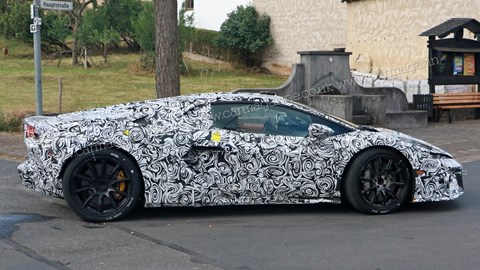► Next-gen Lambo will be a hybrid V8 supercar
► V8 is the brand’s own creation
► Will use Revuelto structure, too
Lamborghini is going from strength to strength. Sales are healthy and, though the Urus SUV is doing a lot of the heavy lifting, it’s backed up by strong performances by the special-edition supercars upon which the company was built. The recently revealed Lanzador is proof, too, that the great e-transition holds no fear for Sant’Agata, even if it is taking its sweet time.
But the two cars that really pave the way for the rest of the decade are the Revuelto, the recently released V12 plug-in hybrid flagship, and this, the Huracan successor. Together they must keep the flame burning by future-proofing the visual, aural and dynamic drama so synonymous with the brand. And against all the odds it looks like they might just manage it…
On paper the Revuelto looked suspiciously like cause for concern, with its groaning kerbweight and all too apparent electro-mechanical complexity. Three e-motors? The Honda NSX and Ferrari SF90 both failed to make compelling arguments for the layout. But the Revuelto blends these elements into a cohesive and adrenaline-soaked driving experience. So there’s plenty of reason to be optimistic that the Huracan’s plug-in hybrid replacement will be pretty special, despite the demise of its naturally-aspirated V10.

Due to be revealed in late 2024, it’s known internally as Project LB634 and has been conceived as a car to eclipse the Ferrari 296 GTB and McLaren Artura. Crucially, though, CAR understands that it’ll distance itself from those rivals on a couple of key points.
Power comes from an all-new 4.0-litre twin-turbo V8 developed in-house by engine chief Davide Bizzarri and his team. Much of the carbonfibre monocoque, suspension layout and hybrid drivetrain are shared with the Revuelto, all of which is huge news. The Artura also uses a carbonfibre tub (the Ferrari’s structure is aluminium) but where both of those cars are rear-wheel drive and deploy single electric motors, the Huracan’s replacement looks set to use a tri-motor layout, as per the Revuelto.

Originally asked to deliver 920bhp, the powertrain was recently reportedly bench-tested at 1100bhp, thereby revealing the true potential of the high-performance engine, which redlines at a hardly tardy 10,000rpm. According to the Lamborghini grapevine, the mid-engined two-seater can accelerate from zero to 62mph in 2.8sec and reach a top speed of 208mph – that’s only three-tenths and 9mph slower than the twice-as-expensive Revuelto.
The 7.2kWh battery – an increase of 3.3kWh over the battery that accompanies the V12 in the Aventador-replacing Revuelto – powers the trio of e-motors, each good for circa 100bhp. One motor sits between the V8 and the eight-speed Graziano twin-clutch transmission, boosting its output, covering when the turbos aren’t raging and providing the equivalent of a reverse gear. The other two motors drive the front wheels via an active torque-vectoring system. Expect up to 12 miles of zero-emissions range, sources say.
To an extent the carbon tub and three-motor powertrain go hand in hand. The composite structure helps offset some of the weight gain implicit in such a complex powertrain, and it’s likely the economies of scale that result from sharing the essential structure across the two cars were key to green-lighting its use in the V12 Revuelto. And while throwing more and more power at rear-drive supercars is a lesson in diminishing returns when it comes to the numbers, the all-wheel-drive traction you get by electrifying the front axle makes a difference. In ideal conditions the new V8 Lamborghini promises to be quicker to 62mph than the Ferrari (2.9sec) and the McLaren (3.0sec). On greasy roads it promises to be considerably quicker.

The three-motor system, with its ability to actively slow and accelerate the front wheels independently (one motor per wheel), also opens up a sandbox of dynamic opportunities. Layer on next-generation driver-assist electronics and it’s a mouth-watering recipe, and we’ve already had a nibble thanks to our recent Revuelto first drive. All of the above might sound horrifically complicated but, as ever, the magic’s in the implementation, and here Lamborghini’s done a fine job. Generating 1001bhp and weighing close to two tonnes, the Revuelto should, by rights, be a handful. Instead it’s by far the most predictable and confidence-inspiring V12 Lamborghini yet, one that always seems to have an answer, not matter how tricky the questions your ambition or ineptitude ask of it. This bodes well for the new V8, though of course the Huracan replacement has a slightly less spine-tingling powertrain to contend with, at least in theory. Perhaps the V8 will be a peach, despite the music-muffling turbos.
Will the new car take over where the Huracan bows out on price? Unlikely. Lamborghini cannot build cars fast enough and so, prompted by similar moves upmarket by Ferrari’s 296 GTB and SF90, not to mention its own Revuelto (which is priced considerably higher than the Aventador it replaces), we expect the new car to be priced closer to £300,000 than £200,000.